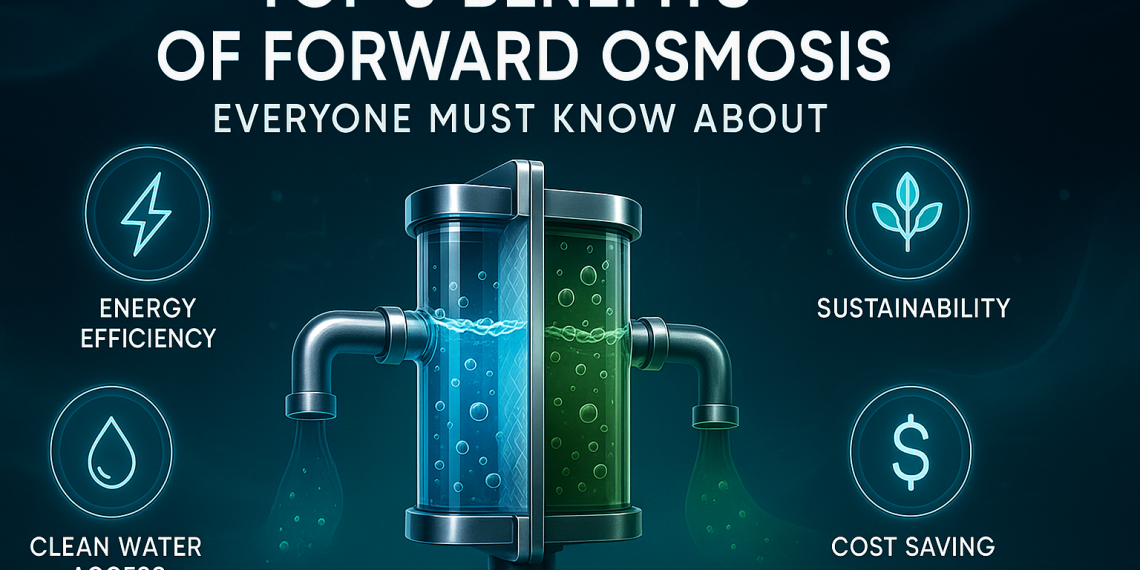Last updated on June 11th, 2025 at 12:32 pm
Forward osmosis (FO) has emerged as a revolutionary water treatment and separation technology, capturing the attention of industries and researchers alike. Unlike traditional reverse osmosis (RO), which relies on hydraulic pressure, forward osmosis utilizes osmotic pressure differentials to draw water through a semi-permeable membrane. The result is a highly energy-efficient and adaptable process that is redefining standards across sectors such as desalination, wastewater treatment, food processing, and pharmaceuticals.
Below, we explore the top 5 benefits of forward osmosis that make it an indispensable tool in modern filtration and water management systems.
-
Exceptional Energy Efficiency in Water Treatment
One of the most compelling benefits of forward osmosis is its low energy consumption compared to traditional membrane filtration technologies.
- FO operates under natural osmotic gradients, eliminating the need for high-pressure pumps.
- This reduced mechanical stress translates to lower operational costs and minimal equipment wear.
- FO is especially advantageous in remote or off-grid locations where energy supply is limited or expensive.
In sectors like brackish water treatment or concentrated brine recovery, forward osmosis significantly outperforms RO by offering sustainable treatment with reduced power dependency.
Read: The Global Perspective: How Commercial RO is Addressing Water Scarcity Challenges
-
Superior Membrane Longevity and Fouling Resistance
Forward osmosis membranes experience less fouling and scaling than pressure-driven systems.
- The gentle osmotic process prevents the compaction of foulants on the membrane surface.
- Membrane cleaning frequency is drastically reduced, lowering chemical usage and maintenance costs.
- The longevity of FO membranes can be two to three times greater than that of conventional RO membranes.
This makes FO ideal for industries dealing with complex or heavily contaminated feed streams, such as textile effluents, mining wastewater, and food and beverage residues.
-
High Recovery Rates and Versatile Feed Compatibility
FO can handle a wide range of feedwater qualities, including highly saline, turbid, and contaminated streams.
- It achieves higher water recovery rates, even from sources where RO is ineffective or uneconomical.
- FO systems are adaptable to zero-liquid discharge (ZLD) strategies, maximizing usable water yield.
- The process can recover water from sludge, leachate, and even landfill waste with minimal pre-treatment.
This versatility supports its integration in municipal wastewater reuse, industrial effluent treatment, and agricultural runoff management.
-
Innovative Applications Across Multiple Industries
The flexibility of forward osmosis system enables its application beyond water purification.
- Food and Beverage: FO is used for concentration of fruit juices, dairy products, and liquid foods without heat damage or nutrient loss.
- Pharmaceuticals: It aids in the recovery of active pharmaceutical ingredients (APIs) and solvent reclamation.
- Power Plants: FO contributes to thermal desalination hybrid systems for cooling tower blowdown water recovery.
- Emergency and Military Use: Portable FO units provide reliable drinking water from contaminated or saline sources in field conditions.
Its ability to function under low energy input and in extreme environments positions FO as a go-to solution for next-gen water treatment challenges.
Read: The Most Effective Way to Eliminate PFAS and PFOA from Your Drinking Water
-
Minimal Environmental Footprint and Circular Economy Support
FO supports environmental sustainability through reduced energy consumption, waste generation, and chemical usage.
- It complements brine minimization and water reuse strategies, lowering discharge volumes.
- FO contributes to circular economy models by enabling water recovery and solute concentration in a single step.
- The technology can be paired with renewable draw solutions and bioprocessing, creating closed-loop treatment systems.
Its integration with green chemistry and zero-waste initiatives is driving a paradigm shift in water resource management.
Forward Osmosis vs Reverse Osmosis: A Strategic Comparison
| Feature | Forward Osmosis (FO) | Reverse Osmosis (RO) |
| Energy Requirement | Very Low | High |
| Operating Pressure | <1 bar (osmotic-driven) | 4–80 bar (pump-driven) |
| Membrane Fouling | Low | High |
| Suitable for Harsh Feeds | Yes | Limited |
| Water Recovery Potential | High | Moderate |
| Pretreatment Requirements | Minimal | Extensive |
| Membrane Lifespan | Longer | Shorter |
| Environmental Impact | Low | High |
This comparison clearly highlights the operational and environmental advantages of forward osmosis over traditional reverse osmosis.
Cutting-Edge Innovations in Forward Osmosis
With growing investments in membrane materials and draw solution chemistry, FO is rapidly evolving.
- Aquaporin-based membranes now offer enhanced selectivity and permeability.
- Magnetic and switchable draw solutes allow easy regeneration with minimal energy input.
- Hybrid systems combining FO with membrane distillation or pressure-retarded osmosis (PRO) are unlocking new efficiencies.
Startups and water tech innovators are leveraging FO to develop modular, mobile, and low-carbon solutions for emerging markets.
Read: $3 Billion for Lead Pipe Replacement to Deliver Clean Drinking Water
Real-World Applications: FO in Action
- Desalination in Arid Regions
Countries in the Middle East and North Africa are piloting FO for brine concentration to enhance overall desalination yield while reducing reject streams.
- Industrial Wastewater Recovery
Textile and pharmaceutical companies are employing FO for difficult-to-treat effluents, achieving 95%+ recovery with lower chemical usage.
- Emergency Response Systems
FO-based hydration packs are used by disaster relief agencies and military units to convert dirty or saline water into safe drinking water on the go.
Why Forward Osmosis Is the Future of Water Purification
As global water scarcity intensifies and energy costs rise, forward osmosis provides a game-changing solution for water-stressed regions and industries alike.
- Its scalability, compatibility with renewable energy, and minimal infrastructure requirements offer long-term viability.
- The integration of FO with AI-based monitoring and automation is making real-time efficiency optimization a reality.
The momentum toward climate-resilient water systems and green industrial processes further cements FO’s role in the next era of sustainable development.
Conclusion: Embracing the FO Revolution
At its core, forward osmosis is not just a water treatment technology—it’s a cornerstone of tomorrow’s resource efficiency. With the ability to address the challenges of energy use, water scarcity, and environmental compliance, FO is the ideal choice for industries, governments, and innovators who demand performance without compromise.
As adoption widens and innovations continue, the top benefits of forward osmosis will only become more pronounced. Whether for commercial scale, crisis response, or decentralized infrastructure, forward osmosis offers a clean, smart, and sustainable path forward.










Stunning images show Arctic glaciers’ dramatic retreat
[url=https://www.5-tv.ru/news/5010745/vot-eta-ulica-vot-etot-dom-nakipre-nasli-villy-gde-skryvaetsa-vasilenko/]анальный секс первые[/url]
Swedish photographer Christian Aslund is riding a small boat along the coast of Spitsbergen, an island in the Norwegian archipelago of Svalbard. Here, deep into the Arctic Circle and midway between Norway and the north pole, he is investigating the health of the glaciers, by comparing them to what they looked like in archival photos.
He takes a picture, trying to place his boat in the exact position occupied by an explorer who took a similar photograph over 100 years ago. But the difference is striking: in the shot from 1918, the boat is heading towards a massive glacier. In the image Aslund took in 2024, he is heading toward what looks like almost bare land.
The comparison is part of a series that Aslund worked on in collaboration with the Norwegian Polar Institute and Greenpeace, to document the retreat of Svalbard’s glaciers over the last century. He visited the area twice — in 2002 and in 2024 — and picked which sites to photograph based on historical images that he found in the institute’s archives.
“In 2002, the widespread knowledge, or acceptance, of climate change wasn’t as broad as it is now,” Aslund says. He published the first set of photos over 20 years ago to create awareness of how much the glaciers were receding. But to his surprise, he received some comments suggesting that the images had been “Photoshopped,” that the glaciers were just expanding and contracting naturally, or that he had taken the pictures in the summer and compared them to archival shots taken in the winter: “But they are not — if you look at at the archive photos, you see that they don’t have any sea ice and not enough snow on the mountains (for it to be winter). And also, in the winter, it’s permanently dark.”
In the summer of 2024, he decided to return, taking pictures at the exact same locations as before. “I had a feeling that the glaciers would have receded even more,” he says, “and that was confirmed. We wanted to show that these glaciers are not going back and forth. They are constantly being pulled back by a warming climate. It’s a major difference.”
The Arctic has been warming twice as fast as the rest of the world since the year 2000, according to the National Oceanic and Atmospheric Administration, but according to other estimates it has warmed even more — four times faster than the global average since 1979. NASA says summer Arctic sea ice is shrinking by 12.2% per decade due to warming temperatures.
Thank you for your sharing. I am worried that I lack creative ideas. It is your article that makes me full of hope. Thank you. But, I have a question, can you help me?
I don’t think the title of your article matches the content lol. Just kidding, mainly because I had some doubts after reading the article.
Your point of view caught my eye and was very interesting. Thanks. I have a question for you.
Your point of view caught my eye and was very interesting. Thanks. I have a question for you.